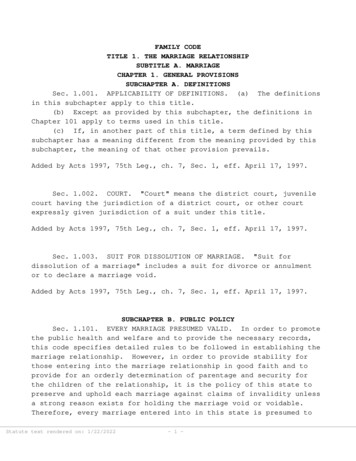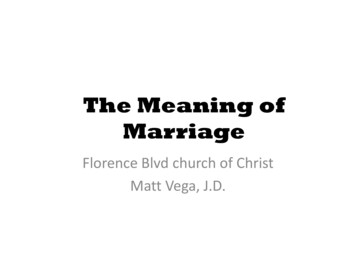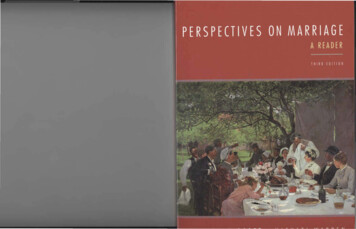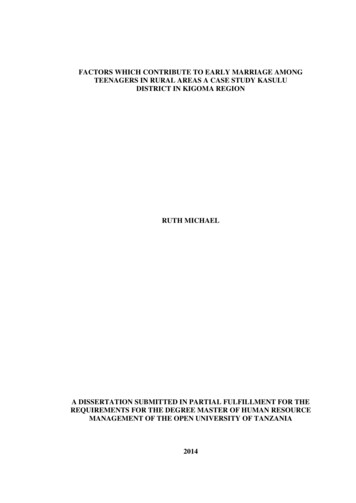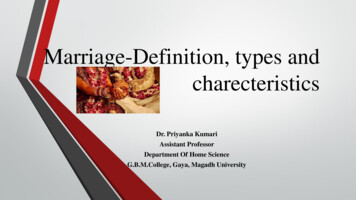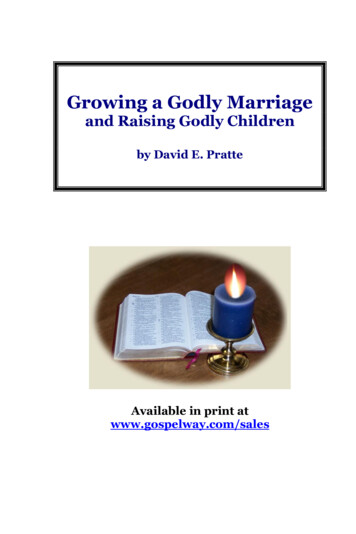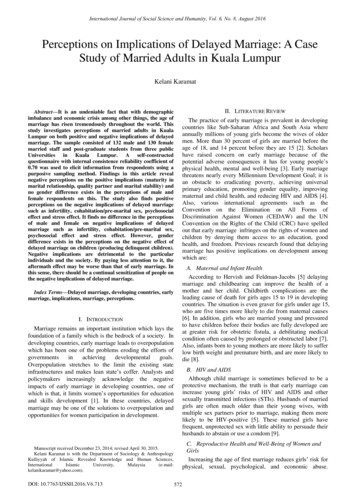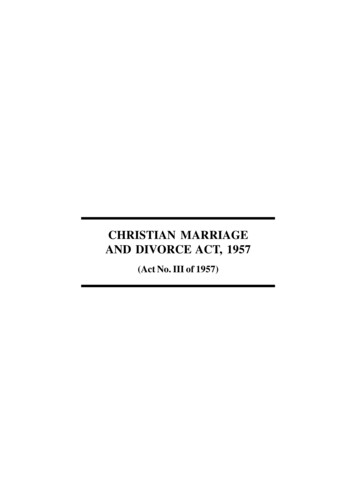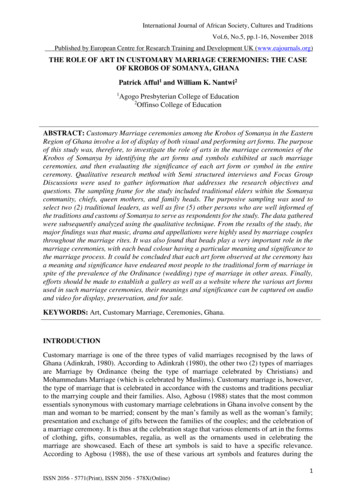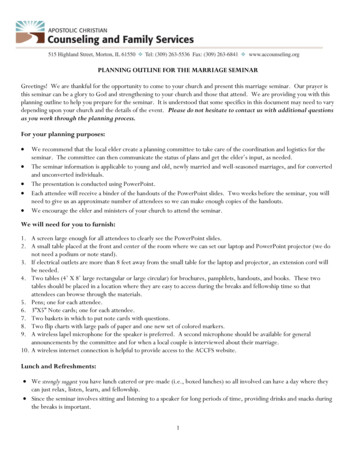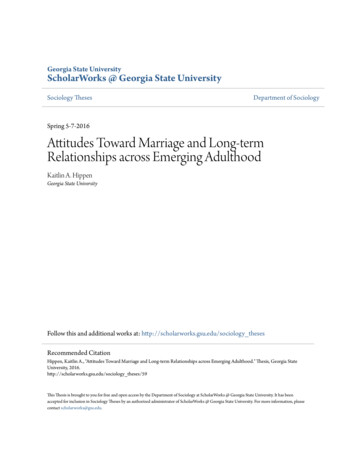
Transcription
Georgia State UniversityScholarWorks @ Georgia State UniversitySociology ThesesDepartment of SociologySpring 5-7-2016Attitudes Toward Marriage and Long-termRelationships across Emerging AdulthoodKaitlin A. HippenGeorgia State UniversityFollow this and additional works at: http://scholarworks.gsu.edu/sociology thesesRecommended CitationHippen, Kaitlin A., "Attitudes Toward Marriage and Long-term Relationships across Emerging Adulthood." Thesis, Georgia StateUniversity, 2016.http://scholarworks.gsu.edu/sociology theses/59This Thesis is brought to you for free and open access by the Department of Sociology at ScholarWorks @ Georgia State University. It has beenaccepted for inclusion in Sociology Theses by an authorized administrator of ScholarWorks @ Georgia State University. For more information, pleasecontact scholarworks@gsu.edu.
ATTITUDES TOWARD MARRIAGE AND LONG-TERM RELATIONSHIPSACROSS EMERGING ADULTHOODbyKAITLIN A. HIPPENUnder the Direction of Daniel L. Carlson, PhDABSTRACTThe current study expands upon existing developmental research on marital attitudechange by examining how attitudes toward marriage and long-term relationships may vary acrossemerging adulthood. Utilizing five waves of data from the Center on Young Adult Health andDevelopment’s College Life Study, discrete-time survival analysis and latent basis growth curveanalysis are employed to assess the change—and predictors of such change—in three measuresof relationship attitudes (desire for marriage, desire for long-term relationships, and importanceof marriage and long-term relationships) of over 900 college students. Results indicate positivechange in all three measures of attitudes, with most emerging adults desiring and placingimportance on marriage and long-term relationships from the very beginning of college.Predictors of attitude change included sex, race, experience of parental death, student status,educational aspirations, and total number of sex partners. Results suggest a need for morelongitudinal research in this area.INDEX WORDS: Marriage, Relationships, Attitudes, Attitude change, Emerging adulthood
ATTITUDES TOWARD MARRIAGE AND LONG-TERM RELATIONSHIPSACROSS EMERGING ADULTHOODbyKAITLIN A. HIPPENA Thesis Submitted in Partial Fulfillment of the Requirements for the Degree ofMaster of Arts in Sociologyin the College of Arts and SciencesGeorgia State University2016
Copyright byKaitlin A. Hippen2016
ATTITUDES TOWARD MARRIAGE AND LONG-TERM RELATIONSHIPSACROSS EMERGING ADULTHOODbyKAITLIN A. HIPPENCommittee Chair:Daniel L. CarlsonCommittee:Dawn M. BaunachElisabeth O. BurgessElectronic Version Approved:Office of Graduate StudiesCollege of Arts and SciencesGeorgia State UniversityMay 2016
DEDICATIONThis thesis is dedicated to my incredible parents, Sherrilyn A. McCullin and Randall D.Hippen, and grandparents, Annette Favorite and Ralph S. Favorite, whose sacrifice,unprecedented encouragement, and unconditional love made it possible for me to pursue highereducation and complete this thesis. I would also like to dedicate this thesis to my significantother, Kevin L. Dunckel Jr., who moved 670 miles to support my educational career. Lastly, Iwould like to dedicate this thesis to my fourth grade teacher, Mrs. Nancy L. Barker, who pushedme to succeed and jumpstarted my love for learning.iv
ACKNOWLEDGEMENTSFirst and foremost, I am extremely grateful to my thesis advisor, Dr. Daniel L. Carlson,for his guidance while working on this thesis. He has shown tremendous patience over the lastthree years and I could not have finished this project without his persistent encouragement. Ihave grown as a writer, researcher, and sociologist because of Dr. Carlson.I would also like to express my gratitude for Dr. Dawn M. Baunach and Dr. Elisabeth O.Burgess. The completion of this thesis would not have been possible without their expertise andassistance.Lastly, I am appreciative of the Center on Young Adult Health and Development(CYAHD) for allowing me to use data from the College Life Study for this thesis and for Dr.Amelia M. Arria, Kimberly M. Caldeira, Kathryn B. Vincent Carr, and Brittany A. Bugbee’ssupport in my growth as a researcher over the last six years.v
TABLE OF CONTENTSACKNOWLEDGEMENTS . vLIST OF TABLES . viiLIST OF FIGURES . viii1INTRODUCTION . 12BACKGROUND . 22.1Second Demographic Transition. 22.2Marital Delay . 42.3Life Course Perspective, Emerging Adulthood, and Attitude Formation. 92.4Marital Attitudes and Variation Across Groups . 162.5Attitude Change. 213METHODS. 243.1Data. 243.2Measures . 273.3Hypotheses . 323.4Analytic Strategy . 344RESULTS . 374.1Desire for Marriage . 374.2Desire for Long-term Relationships . 424.3Importance of Marriage and Long-term Relationships . 465DISCUSSION. 505.1Summary and Implications of Findings . 515.2Limitations . 575.3Conclusion . 58REFERENCES . 61vi
LIST OF TABLESTable 1 Median age at first marriage, by gender: 1960-2010 . 4Table 2 Descriptive statistics for all variables in the desire for marriage analysis . 28Table 3 Descriptive statistics for all variables in the desire for long-term relationships analysis. 29Table 4 Descriptive statistics for all variables in the relationship importance analysis . 30Table 5 Life Table . 37Table 6 Logistic regression analyses of desire for marriage . 40Table 7 Life Table . 42Table 8 Logistic regression analyses of desire for long-term relationships. 45Table 9 Latent basis growth curve analysis of relationship importance . 48vii
LIST OF FIGURESFigure 1 Educational attainment by year: 1960-2010 . 5Figure 2 College degree attainment by gender and year: 1960-2010 . 5Figure 3 Kaplan-Meier Survival Estimate . 38Figure 4 Smoothed Hazard Estimate . 39Figure 5 Kaplan-Meier Survival Estimate . 43Figure 6 Smoothed Hazard Estimate . 44viii
1INTRODUCTIONIn 1960, the median age at first marriage was 22.8 years old for men and 20.3 years oldfor women; today, the median age at first marriage is 28.7 years old for men and 26.5 years oldfor women (Bureau of the Census 2011). Marital delay is the product of economic growth and ashift in cultural values (Lesthaeghe 2010). Because marriage is now postponed until individualsfinish college, become employed, and become financially independent, a new developmentalstage has been established in the life course: emerging adulthood (Arnett 2000; Carroll,Willoughby, Badger, Nelson, McNamara Barry, and Madsen 2007; Gassanov, Nicholson, andKock-Turner 2008; Sassler and Schoen 1999; Willoughby 2010). Emerging adulthood fallsbetween adolescence and young adulthood and ranges from the late teens to the mid- to latetwenties; it is characterized by self-exploration and identity formation (Arnett 2000). During thisperiod, emerging adults form attitudes (i.e. about relationships, marriage, fertility, education, andcareer paths) that guide future decisions (Arnett 2000; Fazio 1986). Attitudes toward, anddecisions about relationships, are important because the choice to engage in long-termrelationships, particularly marriage, has consequences for one’s happiness, life-satisfaction,health, and psychological well-being (Evans and Kelley 2004; Kim and McKenry 2002; Musickand Bumpass 2012; Stack and Eshleman 1998; Umberson, Pudrovska, and Recsek 2010;Vanassche, Swicegood, and Matthijs 2012).Existing research on emerging adults’ marital attitudes is limited because it lacksinformation on if, and how, marital and long-term relationship attitudes change over the courseof emerging adulthood (Willoughby 2010). A longitudinal analysis of marital and long-termrelationship attitude change is necessary in order to better understand emerging adulthood. Thereis reason to believe that attitude change exists during emerging adulthood because emerging1
adulthood is a period of self-exploration (Arnett 2000). Moreover, research suggests that maritalattitude change occurs during adolescence (Willoughby 2010). To determine if there is evidenceof marital and long-term relationship attitude change over the course of emerging adulthood, Iperform discrete-time survival analysis and latent basis growth curve analysis using data fromthe Center on Young Adult Health and Development’s College Life Study. Specifically, thisstudy is driven by two research questions.Research Question 1. How do attitudes toward marriage and long-term relationshipschange over time during emerging adulthood?Research Question 2. What are the predictors of marital and long-term relationshipattitude change among emerging adults?22.1BACKGROUNDSecond Demographic TransitionOver the last two centuries, the United States’ population has experienced a number ofdemographic shifts. In order to explain the historical context in which marriage has beenincreasingly postponed and thus emerging adulthood as a distinct life stage, these demographicshifts must first be explored. The First Demographic Transition that took place between 1800and 1940 in the United States was characterized by a decline in fertility and mortality(Greenwood and Seshadri 2002; Lesthaeghe 2010). These declines were brought on by thetechnological advancements that introduced industrialization and decreased the role ofagriculture in the family and in the job market, making it unnecessary for couples to have manychildren since they were no longer needed as a source of labor (Greenwood and Seshadri 2002).Following the First Demographic Transition, a Second Demographic Transition emerged in the1950s as many other population changes took place; this transition is ongoing (Lesthaeghe 2010;2
Lesthaeghe and van de Kaa 1986). The Second Demographic Transition is characterized by thedelaying of age at first marriage and first birth, decreases in marriage, remarriage, and fertility,and increases in life expectancy, divorce, out-of-wedlock births, contraceptive use, premaritalsex, premarital and postmarital cohabitation, single-parent families, egalitarianism, educationalattainment, and economic independence of women (Lesthaeghe, Oppenheim Mason, and Jensen1995; Lesthaeghe and Neels 2002; Lesthaeghe and Neidert 2006; Sassler and Schoen 1999). Theextent to which these population changes have occurred varies regionally within the UnitedStates, specifically between less-educated, rural areas (particularly Southern and Midwesternstates) and higher-educated, metropolitan areas (particularly Northern and Western states); forexample, Southern states generally have earlier first marriages and lower rates of cohabitation,some Northeastern and Western states have later first marriages and moderate rates ofcohabitation, and the remaining Northeastern and Western states have a larger population ofindividuals who never marry with high rates of cohabitation (Lesthaeghe 2010; Lesthaeghe andNeidert 2006).A shift in needs and values both instigated and propagated the Second DemographicTransition (Lesthaeghe 2010). Specifically, rapid economic growth during the last century and ahalf “produced a shift in concerns from materials needs (subsistence, shelter, physical andeconomic security) to a focus on non-material needs (freedom of expression, participation andemancipation, self-realization and autonomy, recognition)” (Lesthaeghe 2010:213). This isreflective of Maslow’s Hierarchy of Needs, which states that once basic needs (physiological andsafety) have been met, psychological and intellectual needs (love, esteem, and self-actualization)can be focused on (Lesthaeghe 2010; Maslow 1943). As the needs of society changed, so did thevalues. Individuality and diversity became valued over community and social cohesion3
(Lesthaeghe 1983; Lesthaeghe 2010; Lesthaeghe and Neels 2002). This change in needs andvalues has impacted the American family, particularly through the postponement of marriage.2.2Marital DelaySome scholars suggest that a product of the Second Demographic Transition is maritaldelay (Lesthaeghe et al. 1995). The institution of marriage in the United States has undergoneserious change in the last few decades, as evidenced in Table 1 below. As of 2010, U.S. menmarry for the first time at a median age of 28.2 and U.S. women for the first time at a median ageof 26.1 (Bureau of the Census 2011). Since 1960, the median age at first marriage has increasedeach decade by an average of 1.08 years for men and 1.16 years for women.Table 1 Median age at first marriage, by gender: 6.123.9198024.722.0197023.220.8196022.820.3(Bureau of the Census 2011)Many scholars attribute the delaying of marriage in part to the increased economicindependence of women and increased value American job markets have placed on higher levelsof educational attainment (Lesthaeghe 2010; Oppenheimer 1988; Sassler and Schoen 1999).Over the last several decades, the number of people graduating from high school and college hasincreased drastically, as seen in Figure 1 below. In 1960, 42.5 percent of women and 39.5percent of men completed high school, or the equivalent of a GED, and 5.8 percent of womenand 9.7 percent of men received a Bachelor’s or higher level of degree; while in 2010, 87.6percent of women and 86.6 percent of men completed high school, or the equivalent of a GED,and 29.6 percent of women and 30.3 percent of men received a Bachelor’s or higher level of4
degree (National Center for Education Statistics 2012). That means that since 1960, the numberof men and women with a high school diploma or GED has more than doubled and the numberof men and women with at least a Bachelor’s degree has almost quadrupled (National Center forEducation Statistics 2012). Though women and men have completed high school at similar ratesover the last several decades, it was not until 2010 that women and men started completingcollege degrees at a similar rate. This can be seen in Figure 2.100Percentage80High schoolcompletionor higher6040Bachelor'sdegree orhigher200196019701980199020002010Year(National Center for Education Statistics 2012)Figure 1 Educational attainment by year: 980199020002010Year(National Center for Education Statistics 2012)Figure 2 College degree attainment by gender and year: 1960-20105
Because U.S. men and women attend college at higher rates than ever before, many ofthem are delaying marriage until they finish school, find employment, and become financiallyindependent (Carroll et al. 2007; Gassanov et al. 2008; Sassler and Schoen 1999; Willoughby2010). Even women with very traditional gender attitudes—who think women should behomemakers and men should be breadwinners—put off marriage so that they can attain higherlevels of education first (Barber and Axinn 1998). Marriage, then, has become a capstoneachievement, rather than the foundation of adulthood like it has been in the past, with people ofall economic backgrounds waiting until they are financially stable to marry (Cherlin 2004).Several studies find that those with higher educational attainment and higher socioeconomicstatus are more likely to marry than those with less education and lower socioeconomic status(Bramlett and Mosher 2002; Cherlin 2004; Clarkberg 1999; Copen, Daniels, Vespa, and Mosher2012; Goldstein and Kenney 2001; Mahay and Lewin 2007; Sassler and Schoen 1999; Sweeney2002). Goldstein and Kenney (2001) theorize that higher rates of marriage among the morehighly educated can be attributed to greater gains received by both partners upon marryingsomeone with similar financial stability; because men and women are likely to date and marrypeople with similar characteristics, such as educational attainment and careers, those with highereducational attainment and income are likely to benefit at a greater rate from both theirindividual and combined income.Though low-income individuals do wish to marry as much as wealthier individuals, theyare more likely to never marry because of their lack of financial stability and resulting anxietyabout marriage (Cherlin 2004; Edin and Kefalas 2005; Sweeney 2002). Some scholars attributethis dismissal of marriage to a lack of “marriageable men”—a term coined by Wilson (1987)—inthe local marriage market for women to choose from (Lichter et al. 1992; Wilson 1987). The6
financial stability of potential male partners is—both historically and presently—a commonqualification for marriage among heterosexual women, particularly because of women’s pasteconomic dependence on men; thus, marriageable men include those who are employed full-timewith job stability and adequate income, which limits the pool of potential partners yet again(Lichter et al. 1992; Wilson 1987).An increase in young men’s unemployment offers one potential reason for the decrease inthe number of marriageable men available (Lichter et al. 1992). Increased unemployment can beexplained by several changes over the last few decades, but one of the most important changes isthat the job market increasingly places higher earning value on individuals with college andadvanced degrees, making many jobs—especially higher-paying, stable jobs—unobtainable tothose with no access to higher education (Levy and Michel 1991). A decrease in or lack of accessto marriageable men in the local (and national) marriage market explains why some women maybe more likely to postpone marriage until they find a marriageable man and are also more likelyto never marry (Lichter et al. 1992).Racial disparities in educational attainment and income indicate why some groups aremore likely to marry than others because they introduce disparities in the number ofmarriageable men available in the local marriage market (Lichter et al. 1992). The racialdiscrepancy in the likelihood of marriage is quite apparent: 74 percent of White women, 74percent of Asian women, 66 percent of Hispanic or Latina women (57 percent of U.S. born; 72percent of foreign born), and 47 percent of Black women are expected to marry by age 30(Copen et al. 2012). According to Lichter et al., “at age 25, for each unmarried black woman,there are on average only .304 unmarried black men with adequate earnings,” compared to .720“unmarried White men with adequate earnings” per one unmarried White woman (1992:791).7
This demonstrates a large gap in the proportion of marriageable men by race, showing that Blackwomen are clearly disadvantaged in having access to marriageable men within their localmarriage markets, and provides an explanation of why Black women are more likely to postponemarriage or never marry than any other racial group (1992).Though economic factors are important, marital delay is also the result of a major shift incultural values; what individuals want from a marriage has changed and even low-incomeindividuals have shifted their views of marriage and its prerequisites (Cherlin 2004; Edin andKefalas 2005). Marriage has transitioned into what Cherlin has termed an “individualizedmarriage,” from a marriage that was once based on companionship (2004). Self-development,flexible marital and gender roles, and problem solving via open communication characterize theindividualized marriage (Cancian 1987; Cherlin 2004). Rather than forming a union solely forthe purpose of having socially acceptable sexual intercourse, children, and combined bankaccounts like people had in the past, individuals today marry for the purpose of having love andintimacy once they are already financially stable with previously developed careers (Edin andKefalas 2005; Whitehead and Popenoe 2001). Giddens (1991) calls this new type of union a“pure relationship,” which is entered and exited at will by both partners dependent on theirindividual satisfaction.This change in what individuals want from a marriage is particularly due to thepreviously mentioned economic growth and resulting shift in needs, in which individuals canfocus on their non-material and self-fulfilling psychological needs instead of their basicphysiological and safety needs since those are met much easier than they once were (Lesthaeghe1983; Lesthaeghe 2010; Maslow 1943). Additionally, the introduction of birth control andchange in beliefs about sexual morality over the last several decades have opened up room for8
individuals to experience sex without having to get married and to enjoy it with as many peopleas they want within the context of both committed or casual relationships (Arnett 2004).Moreover, because marriage is increasingly reserved for individuals who are financiallyindependent, have higher educational attainment, have higher income, and can afford a wedding,it is now regarded as a status symbol (Cherlin 2004). If a couple can marry, it means they haveachieved a standard of living necessary for marriage (Cherlin 2004; Oppenheimer 1988;Sweeney 2002). Unfortunately this also means that low-income individuals are less likely toachieve access to this status symbol (Cherlin 2004; Edin and Kefalas 2005). Because individualsmust now fulfill these prerequisites prior to marriage, a new developmental stage has appeared inthe life course concomitant with marriage delay: emerging adulthood (Arnett 2000).2.3Life Course Perspective, Emerging Adulthood, and Attitude FormationThe life course perspective is an approach used to conceptualize and explain theprocesses of aging and human development throughout the life course; it considers age, socialties and relationships, timing and duration of roles and transitions, human agency, and the social,cultural, geographical, and historical contexts in which individuals age and develop (Elder andGiele 2009; Holstein and Gubrium 2000; Hutchison 2010). Over the decades, scholars haveattempted to name and describe various life stages in which major changes occur; these sociallyconstructed life stages are used to interpret where individuals are in their physical andpsychological development compared to others in similar contexts, such as in the same age group(Hillier and Barrow 2011; Holstein and Gubrium 2000; Kendall 2013). Life stages are oftenbased on social and economic circumstances and their conceptualization reflects larger socialstructural changes over the course of history; for this reason life stages can be redefined orremoved, and new life stages can be added over time (Elder and Giele 2009; Furstenberg,9
Rumbaut, and Setterson 2005; Hillier and Barrow 2011; Kendall 2013). This is apparent in thefact that life stages look very different for individuals born at different time periods (Elder,Johnson, and Crosnoe 2003).Traditional life stages include those such as infancy (birth to age 2), early childhood(ages 3 to 5), middle childhood (ages 6 to 11), adolescence (ages 12 to 19), young adulthood(ages 20 to 39), middle adulthood (ages 40 to 59), and late adulthood (ages 60 and over) (Hillierand Barrow 2011; Kendall 2013; Rice 1992). It should be noted that although these stages areoften described by a range of ages, their age parameters are only loosely defined and thecharacteristics of each life stage are not necessarily age-specific (Elder and Giele 2009). Lifestages commonly revolve around and distinguish physical developments (e.g. puberty), and lifetransitions (i.e. getting married, having a child). Indeed, transitions mark the movement from onestage to the next, producing life trajectories in one’s life course development (Elder 1998; Elderand Giele 2009).Life stages are dynamic and are added, subtracted, and redefined as social structurechanges. For example, middle adulthood has not always been considered a life stage, as lifeexpectancy used to be much shorter (Kendall 2013). An additional example is that late adulthoodhas recently been broken down into three separate stages—young-old (ages 65 to 75), old-old(ages 75 to 90), and oldest-old (ages 90 and up)— reflecting the differences between those agegroups as life expectancy has increased (Hillier and Barrow 2011). Another life stage that hasbeen added into the life course is emerging adulthood, which follows adolescence and precedesyoung adulthood (Arnett 2000).In the past, the life stage of young adulthood immediately followed the life stage ofadolescence. Adolescence, which was not conceptualized as a life stage until the early 1900s, is10
characterized by physical maturation (puberty and brain growth) and psychological change(increased cognitive ability and identity development and self-discovery), accompanied byphysical, psychological, and social vulnerability (Furstenberg et al. 2005; McCarter 2010).Adolescents usually live at home with their parents or guardians, attend school, and are notconsidered to be full adults, nor are they considered to be children (Kendall 2013). Youngadulthood, which is characterized by independence, marriage, children, and being employed,used to come directly after adolescence (Arnett 2000; Kendall 2013). However, now that manyindividuals in their late teens and early twenties postpone marriage and children to attend schooland participate in other explorative opportunities, most do not feel as though they are adults yetand believe that they are still on their way to adulthood (Arnett 2000). These individuals, roughlyaged 18-25 and often older, are called emerging adults.Arnett (2000) coined the term “emerging adulthood” based on his empirical research torepresent the developmental stage between adolescence and young adulthood. The distinct lifestage of emerging adulthood is most evident in younger cohorts who turned 18 years old in thelate twentieth century or later. This stage can be understood as a product of the SecondDemographic Transition and the delaying of marriage (Arnett 2000; Carroll et al. 2007). The fivemain features of emerging adulthood are identity exploration, instability, self-focus, feeling inbetween (distinct period between the adolescent life stage and the young adulthood life stage),and access to possibilities (Arnett 2004). Emerging adulthood is a time for experimentation, as itoffers a temporarily dynamic lifestyle with no serious life commitments or responsibilitiesoutside of oneself (Arnett 2000). As a “volitional stage,” emerging adulthood provides time foran exploration of “a variety of possible life directions in love, work, and world-views”(2000:469-470); it is characterized as a “self-oriented period” where individuals grasp at their11
independence while also having their parents as a strong source of protecti
ATTITUDES TOWARD MARRIAGE AND LONG-TERM RELATIONSHIPS ACROSS EMERGING ADULTHOOD by KAITLIN A. HIPPEN A Thesis Submitted in Partial Fulfillment of the Requirements for the Degree of
